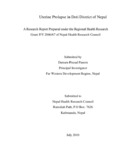Please use this identifier to cite or link to this item:
https://hdl.handle.net/20.500.14356/704| Title: | Uterine Prolapse in Doti District of Nepal |
| Authors: | Paneru, Damaru Prasad |
| Issue Date: | Jul-2010 |
| Keywords: | Uterine Prolapse Associated Factors Perceived Satisfaction |
| Abstract: | Introduction Pelvic organ prolapse is the widespread chronic problem among women in Nepal; particularly among adult and old women of hilly areas. There are 600,000 diagnosed cases of symptomatic Utero-vaginal prolapse. Uterine Prolapse is a condition when the uterus drops from its normal position in the pelvic cavity, escending into and eventually, in extreme stages, out of the vagina. The major purpose of the study was to assess the prevalence and factors associated with Uterine Prolapse in Doti district of Nepal. Methods This was the community based descriptive cross sectional study conducted among the 360 women of the Doti district who have experienced at least once a pregnancy during her life. Three stage stratified sampling procedure was adopted. Face to face interview was conducted with respondents using pre-tested, structured interview schedule. Data were analyzed by statistical package for Social Sciences (16 Version) and results were presented in table and figures. Percentage, mean, median, Chi Square test, Fisher’s exact test, one way ANOVA, correlation coefficient and regression analyses were applied. Results: Prevalence of uterine prolapse was reported to be 35.97 %. Median duration of suffering was 5.5 years. Majorities of the respondents were over 35 year’s age. Visible protrusion was reported by more than 52% cases. All the respondents reported backache, something coming down per vagina and pain around the waist region (> 98%) as major symptoms Family size, literacy status, income, caste, age of respondents, age at marriage; numbers of children, parity, type of delivery, time to resume work after delivery, and associated diseases after delivery were independently and significantly associated with uterine prolapse (p<0.05). The strongest variation was observed due to parity of women followed by type of second and fourth delivery; moreover type of delivery at first, second, third and fourth child birth, age at marriage, numbers of children, parity of women, age at first child birth have was observed to be the strongest associative factors accountings for 40 percent variations. Less than 40% had received treatment of uterine prolapse and most of them received services from hospitals followed by mobile camps. Only 65 % who were treated against uterine prolapse were satisfied with services that they received, nevertheless only 34.6% were fully satisfied. Conclusions Uterine prolapse was observed among large numbers of women; among these almost all were married before the age of 20 years. Illiterates and high parity women were suffered greatly. The perceived service satisfaction was reported to be low among respondents. Women’s empowerment, limiting frequent pregnancies and provision of educational opportunities are recommended for the prevention of uterine prolapse. |
| URI: | http://103.69.126.140:8080/handle/20.500.14356/704 |
| Appears in Collections: | Post Graduate Grant (PG) Reports |
Items in DSpace are protected by copyright, with all rights reserved, unless otherwise indicated.

